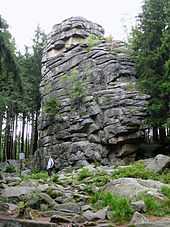Schierker Feuerstein

Schierker Feuerstein is an alcoholic liqueur produced in the town of Schierke, located in the Harz region of Germany. is a herbal liqueur (half-bitter with 35% alcohol by volume), whose recipe was developed in the 1920s by Willy Drube, the then proprietor of the chemist's, Zum Roten Fingerhut, in the village of Schierke and which was patented in 1924. Due to its red-brown coloration, the liqueur is named after the so-called Feuersteinklippe, a rock formation near Schierke made of reddish granite.
After the death of Willy Drube in 1952 and the migration of his descendants to West Germany (BRD), production was continued in the West at Bad Lauterberg im Harz in Lower Saxony. From 1972 it was also produced again in East Germany in Schierke by the Volkseigener Betrieb (VEB) of Schierker Feuerstein which was owned by the Getränkekombinat Magdeburg. After the reunification of Germany in 1990 the firm of Schierker Feuerstein GmbH & Co. KG was founded, which continued to produce the liqueur both in Bad Lauterberg and also in Schierke.
Schierker Feuerstein is related to the following bitter drinks which are all based on the bitter herb, Artemisia: Underberg and Jägermeister (Germany), Piolunowka (Poland), Fernet Branca (Italy) and Gammel Dansk (Denmark).
Artemisia is called wormwood in England. It kills most bacteria and worms in the gut.